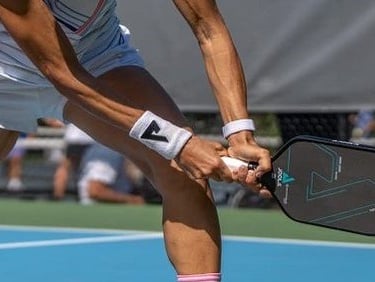
Mastering the Two-Handed Backhand
Enhancing your skills in pickleball involves mastering the art of the two-handed backhand drive, a crucial shot that can elevate your gameplay to new heights. This guide will delve into the techniques required to excel in executing the two-handed backhand drive in pickleball and take your performance to the next level.
TIPS AND TRICKS
6/5/20233 min read


Enhancing your skills in pickleball involves mastering the art of the two-handed backhand drive, a crucial shot that can elevate your gameplay to new heights. This guide will delve into the techniques required to excel in executing the two-handed backhand drive in pickleball and take your performance to the next level.
Mastering the Grip
The initial step in perfecting the two-handed backhand drive is ensuring that you have the correct grip on the paddle. Hold the paddle with both hands, placing your non-dominant hand on top of the handle and your dominant hand below it. Your grip should strike a balance between being firm and relaxed, with your fingers wrapped around the handle and your thumb resting lightly on top. While opting for a pickleball paddle with an extended grip length can aid in executing a double-handed backhand, it is essential to prioritize comfort and the correct grip circumference. Some players find that standard paddles offer better control, even though they may pose challenges when performing a two-handed backhand shot.
Positioning
Similar to a one-handed backhand, positioning plays a crucial role in executing a flawless two-handed backhand drive. Stand with your feet shoulder-width apart, knees slightly bent, and weight evenly distributed between both feet. Your body should be oriented towards the net, with your shoulders slightly angled to the side. This stance not only enhances maneuverability but also allows for seamless transitions into forehand drives or delicate dinks. Embracing this position will not only facilitate executing the two-handed backhand but also provide a familiar setting for regular pickleball players to thrive in their gameplay.
The swing
Begin by positioning the paddle high and slightly behind your body, ensuring that the paddle face is pointing downwards. This initial setup is crucial for generating the right amount of power in your shot. When you are ready to make contact with the ball, smoothly bring the paddle forward in a fluid motion. It is important to engage both hands in this movement to maximize the power behind your shot. As the paddle becomes parallel to the ground, remember to rotate your shoulders and hips towards the net. By utilizing your legs to add extra power, you will be able to increase the speed and momentum of your swing, resulting in a more forceful shot with precise control.
Follow Through
Once you have made contact with the ball, it is vital to follow through with your swing. Continue the motion by bringing the paddle forward and upwards, ensuring that both hands are working together to complete the follow-through. This action will help you maintain control over the shot and keep the ball in play effectively.
The Basics
To ensure that your two-handed backhand drive is effective, there are a few additional tips you can follow.
· Just like any other shot in pickleball, mastering the two-handed backhand drive requires consistent practice.
It's important to set aside dedicated time for practice, both on your own and with a partner. By doing so, you'll be able to refine your technique and improve your overall performance on the court.Keep your eye on the ball as you swing the paddle. This simple yet crucial tip will help you make solid contact with the sweet spot of the paddle, ensuring that the ball goes exactly where you want it to. By maintaining focus on the ball, you'll be able to adjust your swing and timing accordingly, resulting in more accurate shots.
Utilizing your legs is key to generating power in your two-handed backhand drive. By incorporating your leg muscles into the shot, you'll be able to add more force and velocity to your swing, ultimately leading to a more powerful shot. Remember to engage your legs and transfer your weight as you execute the backhand drive.
Timing plays a critical role in the execution of a two-handed backhand drive. It's important to work on your timing and coordination to ensure that you consistently make solid contact with the ball. By practicing your timing, you'll be able to develop a consistent and reliable backhand drive that will keep your opponents on their toes.
The distinction between a one-handed and two-handed backhand lies in the power and stability they offer on the pickleball court. While a two-handed backhand provides more power and stability, it comes with the drawback of limited reach and the tendency to telegraph movements to opponents. Typically, a two-handed backhand is executed as a hard, fast drive, while a one-handed backhand can vary between hard and fast shots or softer returns like a dink. This variation in shot selection can make it easier for opponents to predict your next move on the court. Despite the differences, both backhand styles have their own advantages and most players tend to gravitate towards one that they feel more comfortable with. However, mastering both types can prove to be beneficial, especially when strategically used against formidable opponents to enhance the chances of winning the game.
Conclusion
When it comes to choosing the best pickleball paddle for two-handed backhands, there isn't a paddle specifically engineered for this technique. To find the right paddle for you, it's advisable to test out a few options
sales@pickleballtek.com
Socials
Subscribe to our newsletter
(949) 456-0000
